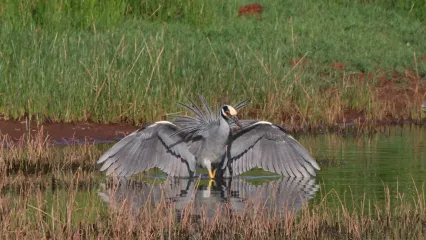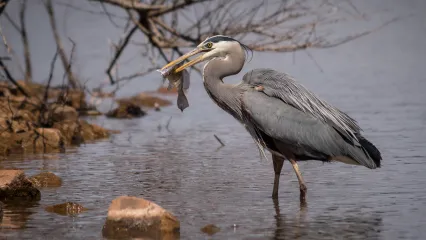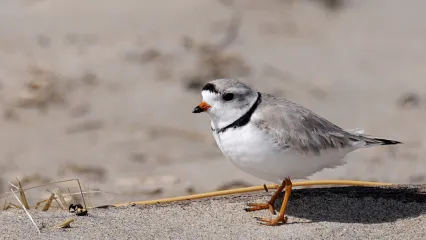
Description
The handsome yet shy yellow-crowned night heron is a summer time resident of Oklahoma. Although this heron's name suggests that it is nocturnal, it is active during both day and night. Even with its daytime activities, coy bird's slow movements make it difficult to spot.
The yellow-crowned night heron is a short stocky bird about half the size of a great blue heron. The long yellow to orange legs contrast with its soft blue-gray body. It is an attractive bird with bright red eyes, black bill and a creamy white crown accented by a black face and white cheek patch. During breeding season, adults have a yellow plume of feathers on their head. The young appearing in mid-June are uniformly brown streaked.
Unlike other night heron species, the yellow-crowned forages day and night. Wading briskly at the water's edge, it will stir up its quarry and, with a quick motion, the sword-like bill stabs its prey. Fish, frogs, grasshoppers, and occasionally snakes make a good meal, but it prefers crustaceans (crayfish). It is also not the uncommon to see one prey upon a small turtle since it has a unique stomach acid to help digest the shell.
The yellow-crowned night heron is a common wetland bird in Oklahoma but is listed as threatened in many of the states within its northeast range. Loss of wetland habitat has had the greatest impact on this species. With continued conservation of our wetland areas and development of new areas, we can help conserve this species for many generations to come.
Habitat
Found throughout the eastern two-thirds of Oklahoma and southeastern part of the United States, the yellow-crowned night yellow-crowned night heron is generally found in shallow backwaters and wetland areas. The yellow-crowned night heron is a migratory bird that resides here in Oklahoma during the summer months.
Life Cycle
During breeding season, the heron will build a nest of sticks and twigs measuring two or three feet across. The nest is generally a substantial platform that can be found on the ground, or low in a tree, by a body of water. The female will lay three to five eggs that are a pale bluish green in color. Both the male and female will take turns incubating the eggs. The eggs hatch in about three weeks, and both parents care for the chicks, feeding them regurgitated food. The chicks fledge when they are about 25 days old.


